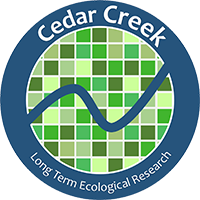Overview
We live in a time of unprecedented change to the Earth’s ecosystems. While understanding the effects of these changes is critical, it is also challenging because effects play out over long periods of time and large spatial scales.
The Cedar Creek Long Term Ecological Research (CDR LTER) site is part of the LTER Network, a group of research sites funded by NSF to address the challenge of long-term, ecological research. LTER sites are chosen to represent major ecosystem types or natural biomes and share the goal of the studying of ecological phenomena over long periods of time based on data collected in five core areas of ecological research.
CDR LTER has been a part of the LTER network since 1982, just two years after the program was started in 1980. Over the course of 4 decades, CDR LTER has become one of the best known ecological research sites in the world. While research at CDR LTER has deepened and expanded over the years to remain at the cutting edge of ecological inquiry, its scientists and staff continue to maintain many of the original experiments and studies, some of which predate the LTER program and are now in their seventh decade. As with other LTER sites, data generated by CDR LTER are considered as the gold standard, because of their quality and duration. These data are freely available to anyone and are used by scientists and educators around the world. In addition to its research mission, CDR LTER supports a large education and outreach program that researches thousands of students, teachers, local residents, and the general public.
CDR LTER is based at the 2200 ha Cedar Creek Ecosystem Science Reserve (CCESR) in central Minnesota, one of two field stations run by College of Biological Sciences at University of Minnesota. CCESR is located at the boundary of three vegetation types that dominate North America: boreal forest, tall-grass prairie, and northern hardwood forest. As a result, CDR is formed by a mosaic of uplands dominated by oak savanna, prairie, hardwood forest, pine forests, and abandoned agricultural fields, and of lowlands dominated by ash and cedar swamps, acid bogs, marshes, and sedge meadows, all on nitrogen-poor soils derived from sandy glacial outwash.
Research has developed over time at CDR LTER, as seen in the funding proposals. Early CDR research developed theory and established observational studies and experiments to understand mechanisms of plant succession and nutrient limitation and test ecological theory. Currently, research at CDR uses long-term observations and experiments, theory, and models to achieve a mechanistic and predictive understanding of (1) how ecological systems will respond to interacting human-driven environmental changes at multiple biological, spatial, and temporal scales and (2) how ecological responses feed back to moderate or amplify environmental changes and alter the ecosystem services that support human well-being.
Current research at CDR LTER is organized around four broad research themes and includes Site-based Research, Synthetic and Cross-Site Studies, and Theory and Modeling.

